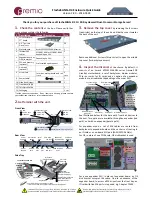
Chapter 1: System Description
Hard Drive Storage
Quantum DXi4700 User’s Guide
22
Note:
Usable storage capacity can be upgraded at any time after purchase by adding a storage
capacity upgrade license to enable installed hardware capacity, or by adding additional hardware
capacity to the system. For information about upgrade options, see the
DXi4700 Capacity Upgrade
Guide
(6-68107), or contact your Quantum sales representative.
Figure 4:
DXi4700 System
1. DXi4700 Node 2. Array Module (RBOD)/Expansion Module (EBOD)
Hard Drive Storage
The DXi4700 system is based upon high speed disk drives instead of tape drives (see
). The usable capacity is 5–135 TB.
l
DXi4700 VTL configurations present the drive storage area as VTL partitions (see
).
l
DXi4700 NAS configurations present the drives storage area as NAS shares and/or OST LSUs (Logical
Storage Units) (see
Network Attached Storage (NAS) on page 25
).
l
DXi4700 Multi-Protocol configurations present the drive storage area as VTL partitions (see
), NAS shares, or OST LSUs (Logical Storage Units) (see
).
By making use of high speed drives, the DXi4700 greatly reduces the time required for backup/restore
functions and improves confidence in completing the backup in the time allowed.
DXi Usage Scenarios
DXi storage presentations are optimized for backup usage rather than file sharing. Backup application
usage is typically characterized by:
l
Aggregated name spaces and file contents.
l
Limited direct, active file access.
l
Limited browsing, scanning, or stating.
l
Limited metadata manipulation (including rename).
Usage diverging from these characteristics must be qualified to ensure acceptable behavior with respect to
functionality, performance, replication, and recovery.
Note:
Using Backup Exec with GRT (Granular Recovery Technology) over CIFS is not recommended
usage. GRT requires frequently overwriting portions of and appending data to existing files, which is
inconsistent with the DXi usage scenarios. Instead, Quantum recommends using OST.
















































